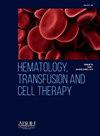RARE CASE! SECOND PRIMARY MALIGNANCY IN LANGERHANS CELL HISTIOCYTOSIS, A JAK2+ CASE
IF 1.8
Q3 HEMATOLOGY
引用次数: 0
Abstract
Objective
Langerhans cell histiocytosis (LCH) is a rare inflammatory myeloid neoplasm characterised by the infiltration of CD1a+CD207+ myeloid dendritic cells and immune cells, thus described as an inflammatory myeloid neoplasm that clonally expands. LCH is a histiocytic neoplasm affecting both paediatric and adult populations, with an estimated incidence of 3 to 5 cases per million children and 1 to 2 cases per million adults. LCH can involve all organ systems, with symptoms ranging from single organ disease to multi-system disease. While it can appear in any organ system, LCH has a particular affinity for bones, skin, lungs, and the pituitary gland. In 2016, LCH was reclassified from a reactive disorder to an inflammatory myeloid neoplasm following the identification of the recurrent BRAF V600E mutation in half of the cases and the observation of clonality. Recently, additional BRAF mutations that activate the MAP kinase pathway have been demonstrated, shedding more light on the pathogenesis of LCH. Several studies have suggested a high prevalence of second primary malignancies, including haematological and solid organ neoplasms, in LCH patients.
Case Report
A 58-year-old male patient, with a known history of hypertension and hypothyroidism, presented to a medical facility in Germany in 2011 with skin lesions on the chest and neck swelling. Following lymph node and skin punch biopsies from the sternum, the patient was diagnosed with LCH, with imaging revealing involvement in the frontal bone of the skull, neck, spleen, axillary, liver, lungs, and skin. The patient was treated with steroids. In 2014, while on holiday in Istanbul, the patient was given 6 cycles of vinblastine in addition to steroids. Steroid treatment was completed over 5 years, followed by regular follow-up. In 2021, the patient presented to Ordu State Hospital with fatigue and skin rashes resembling LCH lesions. Investigations revealed thrombocytosis, erythrocytosis, and leukocytosis. Bone marrow biopsy was reported as normal, and a punch biopsy of the skin lesions showed no evidence supporting LCH. Cytogenetic tests, however, revealed a JAK2+ mutation, which had not been detected in previous tests. The patient was started on hydroxyurea, and imaging showed a 5 cm mass in the spleen, for which splenectomy was recommended, though the patient declined and sought further consultation. Our cytogenetic studies confirmed BCRABL polymerase chain reaction (PCR), PML/RARA, and AML/MDS panel negativity, with JAK2+ positivity. Erythropoietin levels were 6 mU/ml (normal range: 3.7-31.5), LDH was 218 u/l, sedimentation rate was 60 mm/hour, platelet count was 517,000/µl, and white blood cell (WBC) count was 13,000/µl. Physical examination revealed remnants of old skin lesions (Figure 1), and there were no palpable lymph nodes or masses. Imaging showed a significant mass in the spleen and involvement in the frontal bone, liver, lungs, stomach, and neck lymph nodes, similar to previous findings. During follow-up, the patient occasionally reported pain in both legs, and Doppler studies revealed widespread thrombosis, which the patient stated had been occurring for the past 1.5 years but was disregarded. Subcutaneous anticoagulants and anti-stasis treatment (Daflon 1000) were initiated, later transitioning to oral anticoagulants. Follow-up showed improvement in symptoms under hydroxyurea and anticoagulant therapy, but recurring thrombotic events were noted during subsequent check-ups while on oral anticoagulants. Figure 1: Skin findings and biopsy scar marks on the neck, sternum, and abdominal areas of the patient.
Conclusion
Discussion Several case reports and smaller case series have observed that malignant diseases may occur before, concurrently with, or after LCH, with a frequency higher than by chance alone. Edelbroek, J. R., and colleagues linked the emergence of second malignancies in LCH to prior treatments with chemotherapeutic agents such as etoposide or vinblastine, with the second malignancies being identified as leukaemia and myelodysplastic syndrome (MDS). Another study by Goyal, Gaurav, and colleagues followed 1,392 LCH cases, showing that Hodgkin and non-Hodgkin lymphomas developed in children during follow-up, while adults developed MDS in early follow-up and had an increased risk of developing B-cell acute lymphoblastic leukaemia (B-ALL) after about five years. In children, the leading cause of death was infections, while in adults, it was second primary malignancies. In our literature review, we did not encounter any JAK2+ cases or studies following LCH, making the JAK2+ positivity observed in our LCH patient a potentially unique case. We did find that JAK2+ positivity has been observed in the follow-up of non-Langerhans cell histiocytosis. Given that LCH is rare and second primary malignancies are even more uncommon, identifying such cases remains challenging, and further clinical studies are clearly needed.
求助全文
约1分钟内获得全文
求助全文
来源期刊

Hematology, Transfusion and Cell Therapy
Multiple-
CiteScore
2.40
自引率
4.80%
发文量
1419
审稿时长
30 weeks
 求助内容:
求助内容: 应助结果提醒方式:
应助结果提醒方式:


